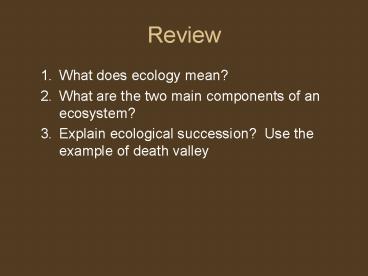Review - PowerPoint PPT Presentation
1 / 32
Title:
Review
Description:
Can you guess what might be the difference in the water for each biome? ... Crayfish land Coastal ocean Open ocean Ocean trench Aphotic zone Photic zone ... – PowerPoint PPT presentation
Number of Views:121
Avg rating:3.0/5.0
Title: Review
1
Review
- What does ecology mean?
- What are the two main components of an ecosystem?
- Explain ecological succession? Use the example
of death valley
2
Ecology Biomes
- Mr. DeGuzman
- Biology A
3
What affects climate?
- Climate in an area is affected by two main things
- Direct sunlight (heat)
- Precipitation
4
Biomes
- There are two main types of biomes
- Land
- Aquatic (water)
- We will speed through both today
5
Land Biomes
- Land biomes
- Tropical Rain forest
- Tropical Dry Forest
- Tropical Savanna
- Desert
- Temperate Grassland
- Temperate Woodland and Shrubland
- Temperate Forest
- Northern Coniferous Forest
- Boreal Forest or Taiga
- Tundra
6
Tropical rain forest
Temperate grassland
Tundra
Temperate forest
Tropical dry forest
Northwestern coniferous forest
Mountains and ice caps
Desert
Temperate woodland and shrubland
Tropical savanna
Boreal forest (Taiga)
7
Ten Major Biomes Ten Major Biomes Ten Major Biomes Ten Major Biomes Ten Major Biomes Ten Major Biomes Ten Major Biomes
Biome Precipitation Temperature Soil Diversity Trees Grasses
Tropical Rain Forest high hot poor high dense sparse
Tropical Dry Forest variable mild rich moderate medium medium
Tropical Savanna variable mild clay moderate sparse dense
Desert low variable poor moderate sparse sparse
Temperate Grassland moderate summer hot rich moderate absent dense
Temperate woodland and Shrubland summer low, winter moderate summer hot poor low medium medium
Temperate Forest moderate summer moderate, winter cold rich high dense sparse
Northwestern Coniferous Forest high summer mild, winter cold rocky, acidic low dense sparse
Boreal Forest moderate summer mild, winter cool poor, acidic moderate dense sparse
Tundra low summer mild, winter cold poor low absent medium
8
Aquatic biomes
- There are 3 main types of aquatic biomes.
- Can you guess what might be the difference in the
water for each biome? - Salt content
- The 3 main types of aquatic biomes
- Freshwater
- Marine (saltwater)
- Estuaries
9
Freshwater Pond Ecosystem
Section 4-4
Spoonbill
Duck
Water lilies
Frog
Dragonfly
Mosquito larvae
Duckweed
Phytoplankton
Snail
Pickerel
Diving beetle
Trout
Hydra
Crayfish
Snail
Benthic crustaceans
Go to Section
10
Figure 4-17 Zones of a Marine Ecosystem
Section 4-4
land
Photic zone
200m
1000m
Coastal ocean
Aphotic zone
4000m
Open ocean
6000m
Ocean trench
10,000m
Continental shelf
Continental slope and continental rise
Abyssal plain
Go to Section
11
Tundra
- Tundra
- Located near the poles
- Treeless biome covered by moss, lichens, and
grasses - Permafrost a layer of permanently frozen subsoil
12
(No Transcript)
13
Boreal Forest
- Boreal Forest or Taiga
- Covered by coniferous (cone bearing) trees.
- Bears, wolves, moose, elk are some of the typical
animals
14
(No Transcript)
15
Temperate Forest
- Temperate forest
- Plants change during the seasons (leaves change
color)
16
(No Transcript)
17
Grasslands
- Grasslands
- Most of the rainfall occurs in one part of the
season - Hot summers, cold winters
18
(No Transcript)
19
Tropical Rain Forest
- Tropical rain forest
- Receive 200-400 centimeters of rain a year
- Constant temperature.
- Home of the most types of animals than any other
biome. Many colorful
20
(No Transcript)
21
Deserts
- Deserts
- Less than 25 cm of rain falls a year
- Both plants and animals must be able to retain
moisture. - Birds, lizards, snakes, insects are typical
- Cactus and sagebrush sparsely cover the area
22
(No Transcript)
23
Freshwater biomes
- Rivers, streams, and lakes
24
(No Transcript)
25
Marine Biomes
- Includes all of the ocean
- Marine biomes are divided into 4 subcategories
- Intertidal zone
- Neritic zone
- Open-sea zone
- Deep-sea zone
26
(No Transcript)
27
(No Transcript)
28
Estuaries
- Estuaries are the boundaries between freshwater
and saltwater. - Since it is a mix of the two, a variety of
organisms can be supported. - Examples of estuaries
- Delta, swamp, lagoon
29
(No Transcript)
30
Homework
- SA 4-3 all questions
- SA 4-4 all questions
31
Handout
- Student led discussion
32
Biome brochure
- First mini project































